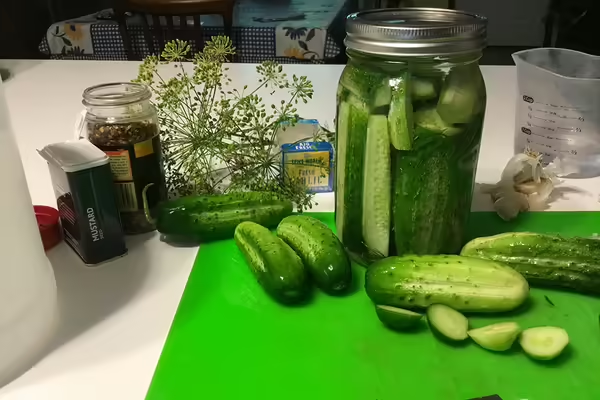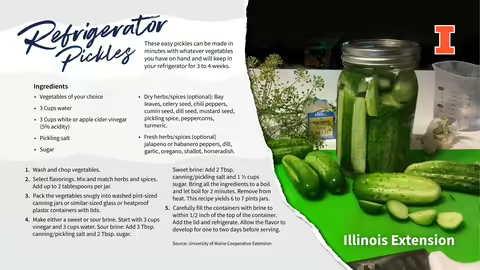
URBANA, Ill. – Sour, sweet, bread and butter, Kosher dills, spears, chips, or slices on a sandwich, or as a snack or side dish – pickles are everywhere. For home gardeners with an abundance of cucumbers and other produce, pickling is a great way to preserve your bounty.
While cucumbers are one of the most commonly pickled items, many foods can be pickled says Mary Liz Wright, University of Illinois Extension nutrition and wellness educator.
“Fruit, eggs, artichokes, mushrooms – you name it and it can probably be pickled,” Wright says.
Pickling is an ancient form of food preservation, dating back to 2030 BC when cucumbers from India were pickled in the Tigris Valley. The word “pickle” comes from the Dutch pekel or northern German pókel, meaning “salt” or “brine.”
The pickling process, for the most part, falls into two categories or methods: quick pickles and fermented pickles. Fresh pack or quick pickles are made with vinegar and salt solution or a vinegar and sugar solution. Fermented pickles require time and salt to do the preserving.
Every region of the world has its own form of pickling as a way to extend the life of fruits and vegetables before refrigeration. Eastern Europe has Kosher dills and lacto-fermented cabbage, known as sauerkraut. English sweet pickles are made with vinegar, sugar, and spices, while the French serve tiny, spiced cornichons or cucumbers. In the Middle East, pickled foods are served with every meal, from olives to lemons. Russians pickle tomatoes, and Koreans have spicy kimchi. The Japanese pickle plums and daikon radishes, and Italians pickle eggplants and peppers.
When selecting cucumbers for pickling, chose fresh and firm pickling cucumbers. Cut 1/16 inch off of the blossom end. Use these ingredients in recipes: canning or pickling salt, white granulated sugar or brown sugar, and vinegar with 5% acidity.
To learn more about how to pickle and to find recipes, visit Illinois Exension’s website go.illinois.edu/PicklingFoods. Wright also suggests exploring the National Center for Home Food Preservation at bit.ly/3LtK6sC. Or, connect with your local Illinois Extension county office at go.illinois.edu/ExtensionOffice.
Refrigerator Pickles
These easy pickles can be made in minutes and will keep in your refrigerator for 3 to 4 weeks.
Ingredients
- Vegetables of your choice
- 3 Cups water
- 3 Cups white or apple cider vinegar (5% acidity)
- Pickling salt
- Sugar
- Dry herbs/spices (optional): Bay leaves, celery seed, chili peppers, cumin seed, dill seed, mustard seed, pickling spice, peppercorns, turmeric.
- Fresh herbs/spices (optional) jalapeno or habanero peppers, dill, garlic, oregano, shallot, horseradish.
- Wash and chop your vegetables.
- Select flavorings. Mix and match fresh or dried herbs and spices. Add up to 2 tablespoons per jar.
- Pack the vegetables snugly into washed pint-sized canning jars or similar-sized glass or heatproof plastic containers with lids.
- Make either a sweet or sour brine. Start with vinegar and water. For a sour brine add 3 Tbsp. canning/pickling salt and 2 Tbsp. sugar. For a sweet brine add 2 Tbsp. canning/pickling salt and 1 ½ cups sugar. Bring all the ingredients to a boil and let boil for 2 minutes. Remove from heat. This recipe yield 6 to 7 pints jars.
- Carefully fill the jars with brine to within 1/2 inch of the top of the rim. Place the lids on the jars and refrigerate. Allow the flavor to develop for one to two days before serving.
Source: University of Maine Cooperative Extension
Photo by Mary Liz Wright. Select fresh and firm pickling cucumbers for preservation. Slice a small portion off of the blossom end and use canning or pickling salt, white granulated sugar or brown sugar, and vinegar with 5% acidity in your pickling recipe.
SOURCE: Mary Liz Wright, Nutrition and Wellness Educator, University of Illinois Extension
ABOUT EXTENSION: Illinois Extension leads public outreach for University of Illinois by translating research into action plans that allow Illinois families, businesses, and community leaders to solve problems, make informed decisions, and adapt to changes and opportunities.
PHOTO ACCESS: The photo and graphic in this article is available to download for media use
